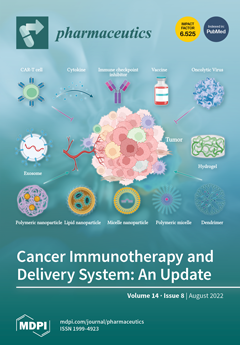Hydrochlorothiazide (HCTZ)/losartan potassium (LOS-K) was used as a model drug to prepare compound tablets through the investigation of the compression and mechanical properties of mixed powders to determine the formulation and preparation factors, followed by D-optimal mixture experimental design to optimize the final
[...] Read more.
Hydrochlorothiazide (HCTZ)/losartan potassium (LOS-K) was used as a model drug to prepare compound tablets through the investigation of the compression and mechanical properties of mixed powders to determine the formulation and preparation factors, followed by D-optimal mixture experimental design to optimize the final parameters. The type and amount of lactose monohydrate (SuperTab
®14SD, 19.53–26.91%), microcrystalline cellulose (MCC PH102, 32.86–43.31%), pre-gelatinized starch (Starch-1500, 10.96–15.91%), and magnesium stearate (0.7%) were determined according to the compressive work, stress relaxation curves, and Py value. Then, the compression mechanism of the mixed powder was investigated by the Kawakita equation, Shapiro equation, and Heckel analysis, and the mixed powder was classified as a Class-II powder. The compaction pressure (150–300 MPa) and tableting speed (1200–2400 Tab/h) were recommended. A D-optimal mixture experimental design was utilized to select the optimal formulation (No 1, 26.027% lactose monohydrate, 32.811% MCC PH102, and 15.462% pregelatinized starch) according to the drug dissolution rate, using Hyzaar
® tablets as a control. Following oral administration in beagle dogs, there were no significant differences in bioavailability between the No. 1 tablet and the Hyzaar
® tablet in HCTZ, losartan carboxylic acid (E-3174), and LOS-K (F < F
0.05). Thus, formulation and preparation factors were determined according to the combination of the compression and mechanical properties of the mixed powder and quality of tablets, which was demonstrated to be a feasible method in direct powder compression.
Full article






